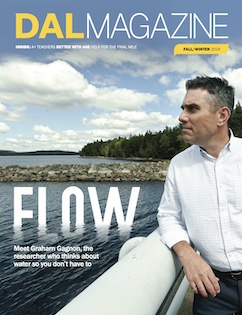When »ĆÉ«Ö±˛Ą researcher Dr. Stefanie Colombo visits the seafood section of her local grocery store, she wants to know two things: where the salmon products come from and whether their labels say that they were farmed.
“My browsing habits have helped inform my research,” explains Dr. Colombo, the Ěýwith the Faculty of Agriculture. “I’ve published two studies that looked at the nutritional content between wild and farmed salmon and I found that the differences are due to species, not whether it was farmed.”
If that news is surprising, you might also be surprised to know that nearly half of the world’s seafood is produced through aquaculture, which is expected to surpass wild seafood production by the end of the decade. In Canada, aquaculture production grew from 50,000 tonnes with a value of $234 million in 1991 to 166,000 tonnes with a value of $1.3 billion in 2022.
Growth by necessity
Ěý
This growth is not being driven so much by consumer preferences as it is by necessity. For years, wild seafood stocks were healthy and sustainable, able to naturally replenish themselves after being harvested. But that has changed dramatically over the past 30 years. There are approximately three billion people worldwide who rely on fish and seafood as a key source of protein each day.
That demand has led to rapid depletion of wild seafood.
“The Food and Agriculture Organization of the United Nations says only two-thirds of our wild fisheries are considered to be in a healthy state,” Dr. Colombo explains. “The reality is we have overfished and if we want to continue having fish from the ocean, then we need to farm a majority of our seafood.”
Related reading:ĚýClimate change is further reducing fish stocks with worrisome implications for global food supplies
Addressing one of the biggest challenges
Ěý
The question is how to farm that seafood in a sustainable way that meets both worldwide demand and our nutritional needs. That is what Dr. Colombo and researchers across »ĆÉ«Ö±˛Ą are trying to answer. Her work is focused on addressing one of the biggest challenges facing the aquaculture industry: how to produce nutritious feed for farmed fish at a sustainable cost. For the most part, feed has been made with fish meal and fish oil harvested from wild fish—an irony not lost on Dr. Colombo. She is exploring opportunities to replace those ingredients with new ones, such as spirulina—a blue-green algae rich in proteins and antioxidants that helps prevent cell damage.
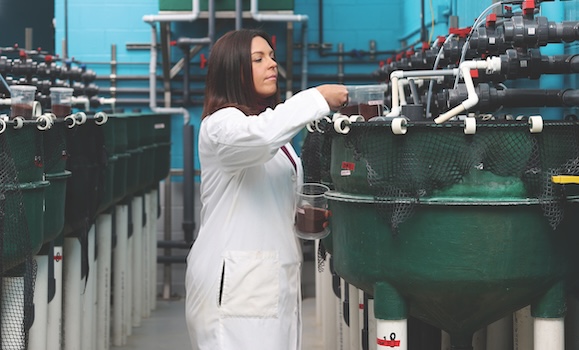
“It’s something that people put in their smoothies,” Dr. Colombo says. “It’s easy to grow and is a commercial product already. We’re testing that in salmon and doing immune trials to see whether they do better with this than their regular diet.”
Related reading:ĚýThe colour of farmed salmon comes from adding an antioxidant to their feed, with benefits for everyone
Enhancing production
Ěý
»ĆÉ«Ö±˛Ą Faculty of Science researcher Dr. Ramon Filgueira is also exploring opportunities for enhancing aquaculture production. He is applying his extensive expertise in sustainable management of coastal aquaculture sites to enhance shellfish production, specifically mussels. He says increased farming of bivalves, such as mussels and oysters, offers opportunities for enhancing both food security and ocean health.
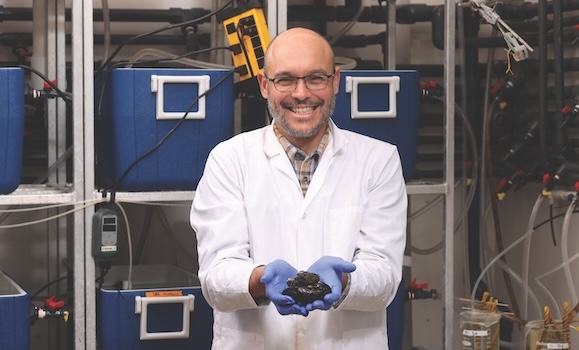
“Unlike, chicken, pig, or even salmon, you don’t need to feed farmed bivalves because they are filter feeders,” Dr. Filgueira explains. “All you have to do is provide them with a habitat and they’ll feed on phytoplankton and detrital organic material, which helps clean the water. That makes them the greenest animal protein we can produce. So, when we talk about our CO2 footprint and what we should eat to be more sustainable, bivalves should be the first option.”
Adapting to climate change
Ěý
However, Dr. Filgueira says climate change is posing challenges for farming mussels in the region. Water temperatures around Prince Edward Island, where most mussels are produced in Atlantic Canada, are gradually getting warmer—a trend that places significant stress on populations and increases the risk for a mass mortality event.
Dr. Filgueira wants to prevent that from happening. He is working with academicĚýand industry partners—including Dal’s Aquatron—to develop more robust mussel seeds that can thrive in warmer water. One approach involves identifying genes and physiological characteristics that will lead to improved hatchery production. Another involves producing triploids, mussels engineered with an extra chromosome that contributes to faster growth and increased attachment to farming structures. That extra chromosome, he notes, renders these mussels sterile, meaning they cannot impact wild populations.
“Using the environmentally friendly protocol we developed for growing different families of triploid mussels, we will explore how they cope with heat stress and then use a data platform we are developing to identify the genetic factors that are contributing to better survival rates and increased growth.” Dr. Filgueira explains. “Once we have that, we will be able to create new, more resilient families of triploid mussels.”
Related reading:ĚýEcosystem engineers: Researchers explore whether oysters can help clean one of Nova Scotia’s polluted waterways
Enhancing growth
Ěý
»ĆÉ«Ö±˛Ą Faculty of Science Associate Professor and Dr. Carolyn Buchwald is taking a different tack in aquaculture research. A chemical oceanographer with an interest in nutrient cycling, she is identifying ways to enhance sugar kelp growth from seed stock with funding though the . Rich inĚýminerals and antioxidants, seaweed is widely consumed in Asia. It’s also a key ingredient in probiotics and nutraceuticals and is used as a food stabilizer.
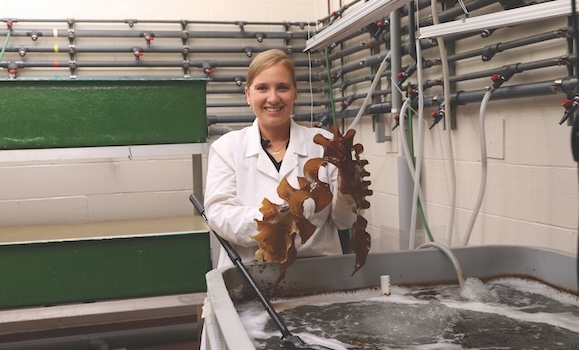
“It can be used in a lot of products, so it is very versatile, but it also offers the potential for us to replace Asian-sourced seaweed in our diet, which contributes to food security,” says Dr. Buchwald.
Sugar kelp starts off being grown in a hatchery, and then is outplanted into the ocean during winter when the nutrients it thrives on are at their peak. Using »ĆÉ«Ö±˛Ąâ€™s Aquatron, Dr. Buchwald is assessing which factors—water sterilization, nutrients, and light—promote quicker, better hatchery growth. This will enable farmers to get their kelp in the ocean in time to benefit from the natural seasonal cycle, and shorten the time in the hatchery, which is their most cost-intensive part ofĚýproduction. But it is becoming increasingly difficult to grow kelp in hatcheries because rising water temperatures make it harder to find wild kelp that is ready to spawn early enough in the season. Dr. Buchwald is exploring a possible solution.
“We’re doing something called forced maturation where we collect kelp that was not ready to spawn, cool the sea water in the Aquatron tanks, and mimic the fall light cycle so that they produce their spawning tissue,” she says. “That means we can spawn them earlier in the season.”
Dr. Buchwald adds that a more robust sugar kelp crop not only contributes to food security, but also a stronger economy, enhanced marine biodiversity, and a healthier ocean. “Sugar kelp produce oxygen, so they’re taking up CO2 and they’re aerating the water,” she says. “But the fact that they are taking up nutrients is also important because excess nutrients can lead to harmful algal blooms, which consume oxygen and block out sunlight.”
Related reading:ĚýResearch project at »ĆÉ«Ö±˛Ąâ€™s Aquatron lab aims to make kelp farming more sustainable
A combined approach
Ěý
As potentially beneficial as these three lines of research are, there is an opportunity to bring them together in an ambitious new initiative that could result in a more sustainable and affordable approach to aquaculture that also increases production. With support through Bringing Worlds Together, Drs. Colombo, Filgueira, and Buchwald plan to explore the potential of integrated multi-tropic aquaculture (IMTA).
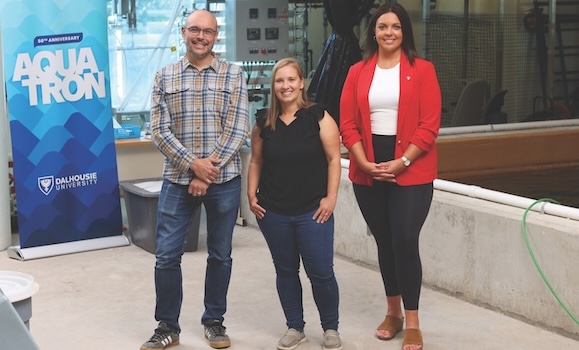
This natural approach to aquaculture mimics the ocean’s ecosystem, where different species provide nutrients for others. In other words, finfish in an IMTA farm would be fed a high-quality diet made from kelp and the waste they produce would then nourish both shellfish and kelp, creating a closed loop.
“Right now, aquaculture is essentially done on a one-input-and-one-species basis, so it is very monoculture focused,” Dr. Colombo explains. “With IMTA, the waste that finfish produce creates an opportunity to grow other things, so the feeds need to be designed with output in mind. That makes it a more efficient approach to aquaculture.”
It is also more ocean friendly, according to Dr. Buchwald. “A lot of fish farms have to fallow their fields because the carbon and nutrients produced make the areas anoxic, or low oxygen, and the sediments become sulfidic,” she says. “By integrating kelp and shellfish, those nutrients and carbon are taken up and that makes growing fish more sustainable.”
With scalability top of mind
Ěý
Although IMTA is not a new concept, it is a difficult one to implement successfully on a commercial scale. Farm operations require both extensive knowledge about marine organisms and multiple licences to meet local regulations. The »ĆÉ«Ö±˛Ą research team plans to create an experimental IMTA site in Nova Scotia so that local producers can test approaches before launching commercial operations. “Essentially, this would be a hub where industry can engage us in research projects to take what they are doing and make it a more integrated approach,” Dr. Colombo says. “It’s a timely undertaking because there is increasing interest in combining kelp and shellfish production on a commercial scale to get two harvestable products.”
If successful, Dr. Colombo hopes that the approaches generated at »ĆÉ«Ö±˛Ą will result in more farms working together on integrated, commercial-scale aquaculture projects across the region. She also believes the team’s work could have far-reaching impacts through the solutions that are developed and the training that will be delivered to students and farmers.
“Aquaculture is more welcomed in other parts of the world,” Dr. Colombo says. “Part of the idea with IMTA is that it could be adopted in places like Central America or Africa. Ideally, we could produce a blueprint that enables countries to become more self-sustaining instead of importing food, which would go a long way to addressing food security issues everywhere.”
"Ideally, we could produce a blueprint that enables countries to become more self-sustaining instead of importing food, which would go a long way to addressing food security issues everywhere.”
This story appeared in theĚýDAL Magazine Fall 2024Ěýissue. Flip through the rest of the issue using the links below.

